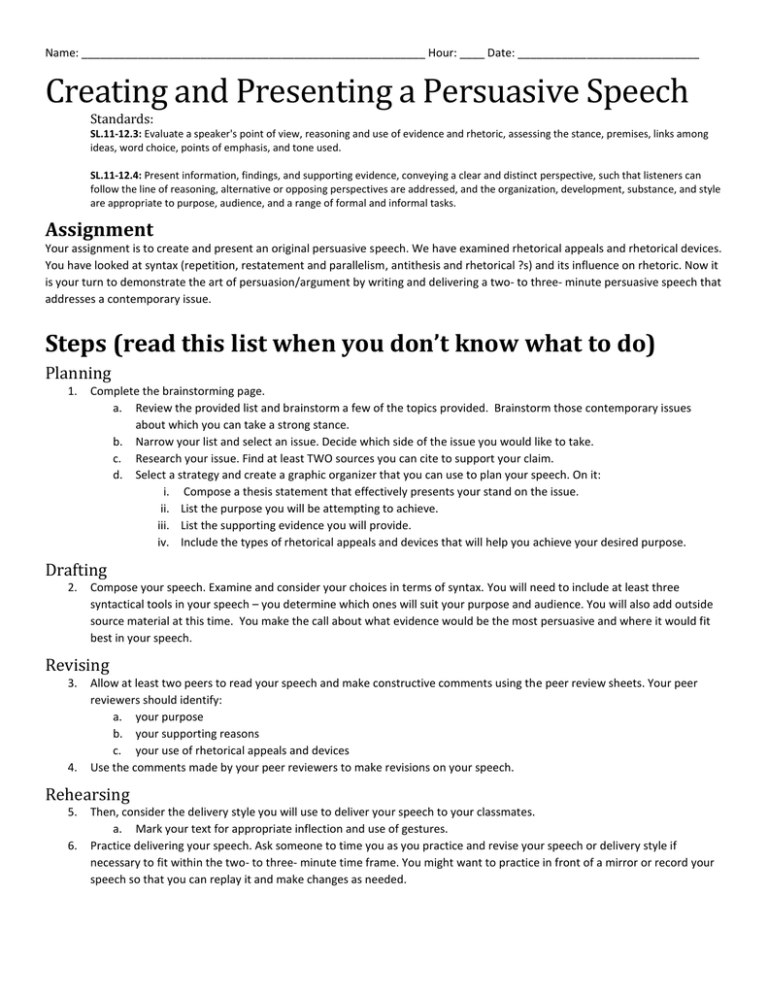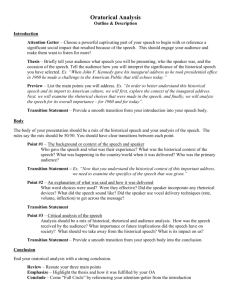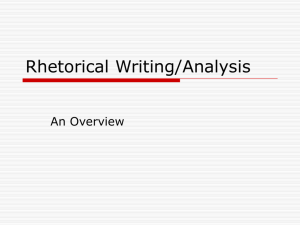Document 15555208
advertisement

Name: _______________________________________________________ Hour: ____ Date: _____________________________ Creating and Presenting a Persuasive Speech Standards: SL.11-12.3: Evaluate a speaker's point of view, reasoning and use of evidence and rhetoric, assessing the stance, premises, links among ideas, word choice, points of emphasis, and tone used. SL.11-12.4: Present information, findings, and supporting evidence, conveying a clear and distinct perspective, such that listeners can follow the line of reasoning, alternative or opposing perspectives are addressed, and the organization, development, substance, and style are appropriate to purpose, audience, and a range of formal and informal tasks. Assignment Your assignment is to create and present an original persuasive speech. We have examined rhetorical appeals and rhetorical devices. You have looked at syntax (repetition, restatement and parallelism, antithesis and rhetorical ?s) and its influence on rhetoric. Now it is your turn to demonstrate the art of persuasion/argument by writing and delivering a two- to three- minute persuasive speech that addresses a contemporary issue. Steps (read this list when you don’t know what to do) Planning 1. Complete the brainstorming page. a. Review the provided list and brainstorm a few of the topics provided. Brainstorm those contemporary issues about which you can take a strong stance. b. Narrow your list and select an issue. Decide which side of the issue you would like to take. c. Research your issue. Find at least TWO sources you can cite to support your claim. d. Select a strategy and create a graphic organizer that you can use to plan your speech. On it: i. Compose a thesis statement that effectively presents your stand on the issue. ii. List the purpose you will be attempting to achieve. iii. List the supporting evidence you will provide. iv. Include the types of rhetorical appeals and devices that will help you achieve your desired purpose. Drafting 2. Compose your speech. Examine and consider your choices in terms of syntax. You will need to include at least three syntactical tools in your speech – you determine which ones will suit your purpose and audience. You will also add outside source material at this time. You make the call about what evidence would be the most persuasive and where it would fit best in your speech. Revising 3. 4. Allow at least two peers to read your speech and make constructive comments using the peer review sheets. Your peer reviewers should identify: a. your purpose b. your supporting reasons c. your use of rhetorical appeals and devices Use the comments made by your peer reviewers to make revisions on your speech. Rehearsing 5. 6. Then, consider the delivery style you will use to deliver your speech to your classmates. a. Mark your text for appropriate inflection and use of gestures. Practice delivering your speech. Ask someone to time you as you practice and revise your speech or delivery style if necessary to fit within the two- to three- minute time frame. You might want to practice in front of a mirror or record your speech so that you can replay it and make changes as needed. Presenting 7. Be prepared to give your speech on the day your teacher assigns. a. Consider how your physical appearance will affect your delivery, and try to dress appropriately for the nature of your speech. b. Be prepared to submit a final draft of your speech to turnitin.com prior to your presentation. Reflecting 8. As you view your peers’ speeches, fill out the speech viewing guide. a. After all speeches have been presented, complete the written reflection (you’ll get this later). Persuasive Speech Scoring Guide Scoring Criteria Ideas Use of outside support Use of Language Presentation Reflection A B-C D-F The speech presents a significant and compelling thesis on a contemporary issue; the thesis is clearly developed and supported. The argument is convincing and adeptly uses a variety of rhetorical appeals (ethos, pathos, logos) and at least 3 syntactical tools. The speech presents a clear thesis on a contemporary issue; the thesis is sufficiently developed and supported. The argument is plausible and effectively uses rhetorical appeals and some syntactical devices. Outside sources are quoted as support for claims. Sources are relevant and compelling. Speaker uses at least 2 sources in a highly effective manner. The speaker deliberately and effectively uses rhetorical devices and varied syntax for the intended purpose. The speaker demonstrates well-placed inflection and gestures that create an engaging delivery style indicative of advance preparation and rehearsal for the delivery. Outside sources are used to support claims, but may not be compelling. Speaker uses the minimum of (2) sources somewhat effectively. The speech presents a position that is difficult to distinguish or is insufficiently developed and supported. An attempt has been made to make an argument, but it is not plausible and uses persuasive appeals ineffectively. It fails to implement effective syntactical devices. Outside sources may not be used or are used in a way that does not support claims. Sources may not be credible or present. The writer’s reflection demonstrates a thorough and detailed analysis of the components of an effective speech. The speaker clearly attempts to use rhetorical devices and varied syntax for the intended purpose. The speaker demonstrates some use of inflection and gestures that create an appropriate delivery style indicative of advance preparation and rehearsal. The overall organization of the speech shows a thoughtful attempt to encourage audience engagement. The writer’s reflection demonstrates an adequate analysis of the components of an effective speech. If the speaker attempts to use rhetorical devices and varied syntax, the result is ineffective for the intended purpose. The speaker demonstrates minimal use of inflection and gestures to create an appropriate delivery style indicative of advance preparation and rehearsal. The speech is disorganized and shows little attempt to encourage audience engagement. The writer’s reflection demonstrates a minimal analysis of the components of an effective speech.




